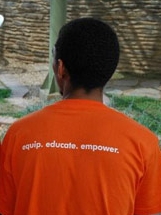I am Roxana Bassi, an ICT Specialist at the Global e-Schools and Communities Initiative (GeSCI).
At GeSCI, we have developed some guidelines as a reference guide for Ministries of Education (MoE) when considering the selection and purchase of low cost computing devices (hardware), as one of a number of solutions intended to meet educational (i.e. teaching and learning) and/or e-administration objectives.
Given the drive by many Ministries to effectively deploy appropriate information and communication technologies (ICT) tools/devices into the educational sector, careful consideration has to be given to the choice of device deployed, as an inappropriate choice can limit the educational possibilities.
Furthermore, many of these devices have only been developed and tested in the past couple of years and in some cases still need to prove their "value-add" in terms of their ability to support the sector in meeting educational objectives. As the investment costs are substantial, a careful analysis of the options must be undertaken, to determine, in particular, the Total Cost of Ownership (TCO) for such an investment.
The low-cost computing devices toolkit seeks to outline, from a technical point of view, a number of factors that should be considered and analyzed when comparing different devices. The matrix as provided intends to identify and describe the different components to consider.
The toolkit can be used as:
- An evaluation tool, used as a guide during presentations with vendors to ensure that a TCO (Total Cost of ownership) approach has been employed to evaluate the offering; or
- As an evaluation tool, to be sent to vendors to complete and return to the Ministry, as part of the discussion phase when considering new devices/tools.
- The first document provides a series of technical variables that should be considered when analyzing and/or comparing different devices. A simple rating scale should be developed (e.g. with 5 being the highest rating and 1 being the lowest). Note however that any rating scale used should be defined by the country according to its priorities.
- The second part (page 10) of the document outlines a series of factors to take into account when considering implementation of portable educative devices projects in any given country.



How does the OLPC fare using this matrix?
Dear Roxana, thank you for alerting us to the GeSCI tool. I'm sure that it will be valuable to MOEs. My quick scan suggests that:
- The tool _mostly_ asks for information that should be included in any hardware specification for procurement
- The tool doesn't start with a needs assessment.
- The tool is biased toward mobile computing options
Questions:
- How should MOEs and others determine whether they need low-power computers?
- What are the spec/procurement considerations that are _distinct_ or more critical to low-power devices (e.g., manufacturing capacity! sourcing parts!)
-How should they determine whether they need mobile computers?
- What other systems (generators, micro-hydro, solar) need to be linked to decisions about low-power hardware? How do deciscions about these systems impact cost? (!)
- How do they assess the power requirements of thin-client networks?
Also, IMHO it's critical to acknowledge that there are many low-power/low-cost devices that aren't mobile. And that mobile options may not be best in all circumstances (e.g, you're buying 25 devices for a schools with 1300 kids).